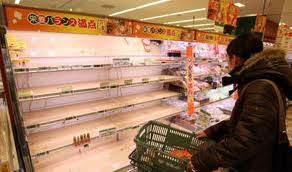 Happy springtime, everyone! In the last month or so we’ve seen food prices hitting record highs and budget discussions around food get heated, so let’s jump right into the thick of it.
Happy springtime, everyone! In the last month or so we’ve seen food prices hitting record highs and budget discussions around food get heated, so let’s jump right into the thick of it.
- In the wake of March’s devastating earthquake and accompanying tsunami, Japan is struggling with a nuclear crisis whose severity rivals that of Chernobyl. What you may not know is that this devastation has brought with it a food crisis. Once word got out about a potential radiation leak, millions rushed to stores to stock up on food, water, and other everyday essentials. Now, as a result of the breaches at the Fukushima nuclear plant, large tracts of agricultural land are irradiated and unusable.
- Food shortages aren’t limited to Japan, though. Following last year’s U.S. Census, the USDA released an interactive infographic that illustrates the locations of so-called “food deserts” – defined as a location where healthy and affordable food is scarce for one reason or another. The spread of food deserts seems to correspond with the fact that food prices have hit a 20-year high this year. But there’s also some startling demographic data associated with the trend. Major grocers who can provide relatively inexpensive and healthy options are abandoning urban minority populations, leaving them with few options other than fast food joints. These areas, unsurprisingly, are a huge factor in the national obesity epidemic.
- In related news, the coffee bean futures market has reached its highest peak in the last 34 years. Owing largely to repeated years of low production on Colombian farms, the supply of beans is in bad shape. This, in combination with a growing coffee-drinking middle class in countries like Brazil, Russia, India and China, creates a perfect storm of supply and demand. As a result, wholesale costs on beans are shooting way up, with many roasters being forced to increase their prices. (Meanwhile, futures brokers are sipping their Frappuccinos all the way to the bank). The good news is that the International Coffee Organization predicts that in the coming months, Colombian coffee production should increase in comparison to previous years.
- If you watched the news during April, you probably found that the drawn-out battle over the federal budget was pretty inescapable. Among the proposed spending cuts was a $5.7 billion dollar slash to the USDA and FDA budgets. Ultimately, the USDA alone saw its budget drop by $2.6 billion. These cuts will have a major impact on sustainable agriculture conservation, biodiversity, environmental quality incentives, wetland reserves programs, and other areas of immediate concern for the food and farm crowd. That’s not to say that the USDA has been perfect when it comes to conservation, etc., but it’s nevertheless the most important organizing force in America in those fields.
These are some wild days in the world of food and farm. If you notice any fascinating food and farm news you think should be included in my next update, send it my way!